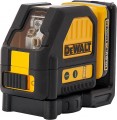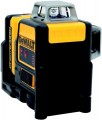Suitable for
General purpose of the device.
This parameter is indicated for models that have a clear specialization - these are mainly laser levels, including rotary ones. Among such devices, there are the following application options:
for the 360° area, only
for point projections,
for the floor and
for pipes. Here are the features of each of these varieties:
— For 360° area coverage. A full circle, 360°, by definition covers all rotary levels (see “Type”). However, such specialization can also occur in “regular” laser models. In such devices, full 360° coverage is achieved in other ways - usually by the presence of several emitters, each of which covers its own sector, or a special prism that scatters the beam from one emitter over a full 360°.
- Point projections only. Levels with this feature do not form marks in the form of lines during operation and “draw” only points. At the same time, in the simplest models there is only one point projection, but devices with several marks (up to 5) are more common. In any case, such devices are intended for relatively simple work where there is no need for marking along lines.
- For the floor. Levels designed for working with floors - screeds, laying coverings, etc. A common feature of such devices is a fairly wide base, which allows, in fact, to place the device di
...rectly on the floor. But the specific design and operating features of levels of this type may be different. Thus, devices with a characteristic layout are quite popular - with two vertical projections intersecting at an angle of 90° (some models provide two more projections directed in opposite directions from the main ones). Such a device can be used not only on the floor, but also on walls: if you press its base tightly against a particular surface, it will form two clearly perpendicular lines on it. In the case of floors, this can be convenient, for example, when laying tiles.
Another common type of floor level is devices designed to detect unevenness. To do this, use a line formed on the floor using a vertical projection. During operation, a level placed on the floor and aligned horizontally rotates around a vertical axis, and the line “scans” the floor; when it hits a ledge, it becomes uneven. Note that in the simplest models, such a “scanner” uses only one projection, but there is also a more advanced version - a line created by two projections at once. Such a pointer, when it hits an uneven floor, is divided into two separate lines - this is much more noticeable than the deviation when using a single projection.
- For pipes. A rather rare type of specialized laser levels are devices for laying pipelines. They are used, in particular, in the construction of water supply, sewer and stormwater systems. Pipe levels most often have a characteristic cylindrical shape, with a handle at one end and a point laser emitter at the other. They are installed horizontally on special legs (the kit usually comes with several sets of such legs, varying in height); the design usually has a self-leveling mechanism with quite extensive capabilities; and the necessary measurement accuracy is ensured by a target with special markings. Such devices allow you to at least accurately lay horizontal lines, and many of them also allow you to work with corners.Measurement range
The range at which the device remains fully operational without the use of additional receivers (see below); in other words, the radius of its action without auxiliary devices.
In some models, a range may be specified that shows the minimum (
3 cm,
5 cm) and maximum measurement ranges. But in most cases, only the maximum value is indicated.
The specific meaning of this parameter is determined by the type of instrument (see above). So, for optical levels, the measurement range is the greatest distance at which the operator can normally see the divisions of a standard leveling staff. For laser levels, this parameter determines the distance from the device to the surface on which the mark is projected, at which this projection will be easily visible to the naked eye; and in rangefinders we are talking about the greatest distance that can be measured. Typically, the measurement range is indicated for ideal conditions - in particular, in the absence of impurities in the air; in practice, it may be less due to dust, fog, or vice versa, bright sunlight "overlapping" the mark. At the same time, tools of the same type can be compared according to this characteristic.
Note that it is worth choosing a device according to the range of action, taking into account the features of the tasks that are planned to be solved with its help: after all, a large measurement range usually significa
...ntly affects the dimensions, weight, power consumption and price, but it is far from always required. For example, it hardly makes sense to look for a powerful laser level at 30-40 m if you need a device for finishing work in standard apartments.Measurement range (with receiver)
The longest measurement range provided by a laser level (see “Type”) when using a special receiver with a photocell.
Thanks to its sensitivity, such a receiver is able to respond even to a weak laser beam, the mark from which is no longer visible to the naked eye; At the same time, the area of the photocell is quite large, and special indicators make it possible to determine the exact position of the mark. Among other things, this significantly expands the range of action of the level - the measurement range with a receiver is usually several times greater than without it. On the other hand, such equipment inevitably affects the overall cost of the device; and in some models the receiver
is not included in the package at all; it must be purchased separately. However, the second option also has its advantages: you do not need to immediately pay for an additional accessory, it can be purchased later, when a real need arises, while some models allow you to choose the optimal receiver model from several options at your discretion.
Note that the receiver can be useful not only for increasing range; These points are described in detail in paragraph “Included parts”.
Operating temperature
The temperature range at which the device is guaranteed to work for a sufficiently long time without failures, breakdowns and exceeding the measurement error specified in the characteristics. Note that we are talking primarily about the temperature of the device case, and it depends not only on the ambient temperature — for example, a tool left in the sun can overheat even in fairly cool weather.
In general, you should pay attention to this parameter when you are looking for a model for working outdoors, in unheated rooms and other places with conditions that are significantly different from indoor ones; in the first case, it makes sense to also make sure that there is dust and water protection (see "Protection class"). On the other hand, even relatively simple and "myopic" levels / rangefinders usually tolerate both heat and cold quite well.
Tripod thread
The standard size of the thread used to mount the level/rangefinder on a tripod (if available). This option can be useful if you already have a surveying tripod that you want to use with the tool.
The most popular options in modern devices are 1/4" and 5/8". It is worth noting that 1/4" is a standard size for
photographic equipment - accordingly, levels with such a thread can be installed even on ordinary
photographic tripods.
Diode emission
The wavelength of the radiation emitted by the LED of the level or rangefinder; this parameter determines primarily the colour of the laser beam. The most widespread in modern models are LEDs with a wavelength of about 635 nm — at a relatively low cost, they provide bright red radiation, giving a well-visible projection. There are also green lasers, usually at 532 nm — the marks from them are even better visible, but such LEDs are quite expensive and rarely used. And radiation with a wave longer than 780 nm belongs to the infrared spectrum. Such a laser is invisible to the naked eye and is poorly suited for leveling, but it can be used in rangefinders — of course, with a viewfinder (see "Type" for more details).
Laser colour
The color of the laser beam emitted by the device.
Red lasers are the most popular in our time: they are relatively inexpensive, while they are quite effective and functional, and also quite noticeable on most surfaces. In turn,
green lasers are better visible to the human eye (with the same emitter power); however, they are noticeably more expensive than red ones, consume more energy and have a shorter service life, and therefore are much less common.
Blue lines are rarely seen in laser instruments. Their competitive advantage over traditional green and red lasers is their high brightness, which ensures excellent visibility of the beams on many surfaces, incl. when doing outdoor work.
In some devices, you can find two types of lasers at once - both red and green. As a rule, these are levels with several projections, where green is used to build planes, and red is used for point projections.
Beam angle (vertical)
The sweep angle in the vertical plane provided by the level emitter. If there are several such radiators (for example, on both sides of the case), this parameter is given for each of them separately.
The sweep angle is, in fact, the coverage angle, that is, the width of the sector captured by the emitter when the line is formed. The wider this angle, the more convenient the device is to use, the lower the likelihood that the device will have to be moved up and down to build a line. On the other hand, a larger sweep angle (at the same range) requires more power — and this, accordingly, affects the cost and power consumption.
Beam angle (horizontal)
The sweep angle in the horizontal plane provided by the level emitter. If there are several emitters, their total coverage angle is indicated here; a typical example of such devices are models for full 360 °, not related to rotation.
Actually, all rotary devices, by definition, provide a coverage of 360 °. Therefore, it is worth paying attention to this parameter in cases where we are talking about more traditional laser levels. And here it is worth considering that a larger coverage angle, on the one hand, can provide additional convenience, on the other hand, it increases the price and power consumption of the device. So when choosing, you should proceed from real needs; detailed recommendations on this subject can be found in special sources.

